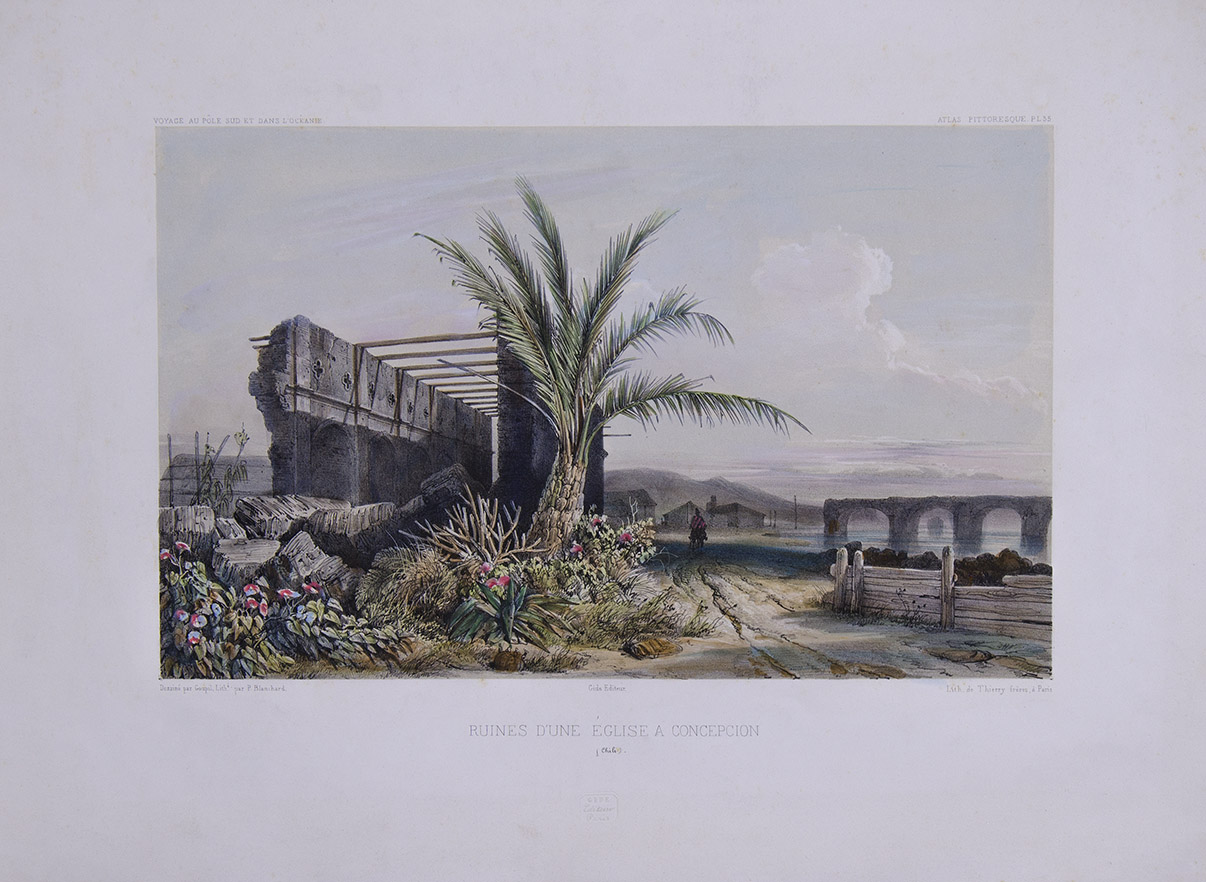Ruines d`une eglise a Concepcion.
Ruines d`une eglise a Concepcion. (Chile) Dessiné par Goupil, Lithe. par P. Blanchardrd. Lith. de Thierry Freres, á Paris. (1842) Paris: Gide, [1846]
Lithograph on paper, illuminated. Measures. Engraving box: 20 x 32.5 cm / 7.87 x 12.79 in. Paper: 35.2 x 53.2 cm / 13.85 x 20.94 in. The work is in great condition. It is displayed framed.
With the foreground of a palm tree and the vegetation that flourishes among the rubble, we observe behind the ruins of a church and towards the center of the composition, the silhouette of a horseman who, pumped up, advances towards the coastal hamlet -apparently- the old location of Concepción, then called Penco; to the Goupil pass, uninhabited. (1) In the distance, the profile of the mountains that fall on the sea. On the right a wooden fence and emerging from the water, the remains of an old construction with semicircular arches. The image of the ruins was a subject of special interest in European iconography, here rescued in Chilean territory by one of the artists embarked on the French expedition, Ernest Auguste Goupil (1814 - 1840), who was traveling in the Zélée, while that Louis Le Breton (1818 - 1866) did in the Astrolabe. The ruins in this scene are testimony to the earthquakes. Concepción suffered those of 1751 and 1835, and others in the twentieth century.
The work was included in the Atlas Pittoresque (Plate 35) of the work Voyage au Pôle Sud et dans l'Océanie sur les corvettes L'Astrolabe et La Zélée. The expedition was under the command of Jules Dumont-D´Urville (1790-1842) and its first objective was to explore the Antarctic ice cap -in moments of dispute over its possession- and then the return of D'Urville to Oceania, by the Strait of Magellan, to finalize the pioneering studies begun on Astrolabe's first voyage between 1826 and 1830. These voyages were central to reversing the geographical limits imposed on French possessions due to the Napoleonic defeat.
Note:
1. The 1751 earthquake -which caused the destruction of the Church of San Francisco, provoked the transfer of the population to its current location, renaming it Concepción. The old Penco site was reoccupied at the end of the 19th century. (In AAVV: "History and Archeology of the Church of San Francisco in Concepción de Penco ..." Published in the Bulletin of the Chilean Archeology Society. Num. 49, 2019, pp. 27-36)
We thank Doctors Patricia Méndez and Ignacio Bisbal Grandal for the information provided, both academics from the Universidad del Bio-Bio (Chile).
OMM
| AUTHOR | ERNEST AUGUSTE GOUPIL |
|---|
Are you interested in selling some works?
Send us an email briefly indicating
which works you intend to put on sale, and we will respond. click here
Subscribe to our newsletter to be updated.
Check our Newsletters